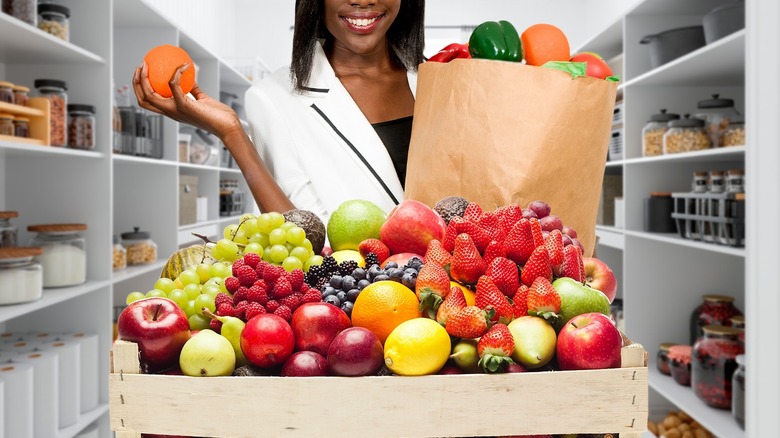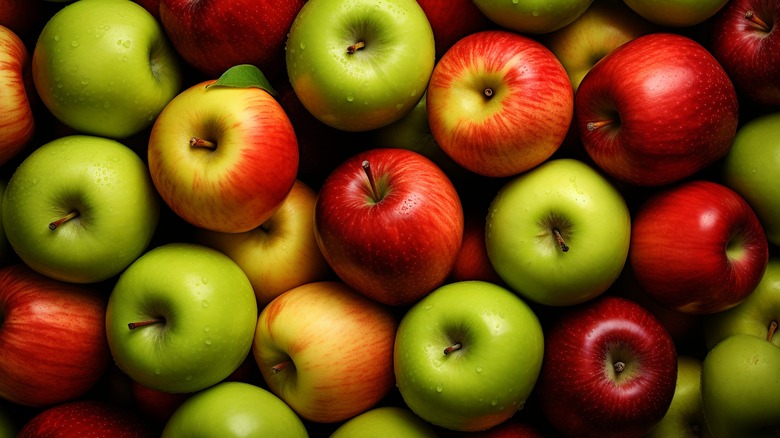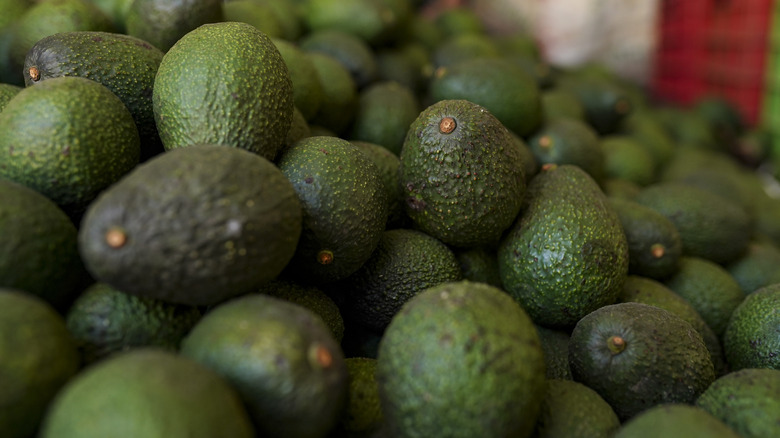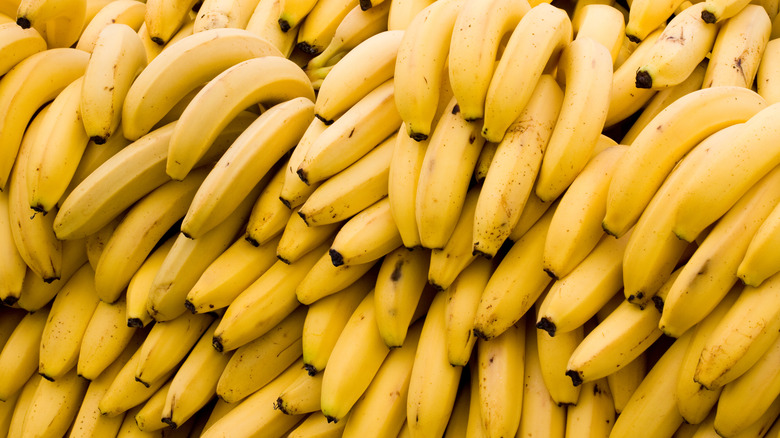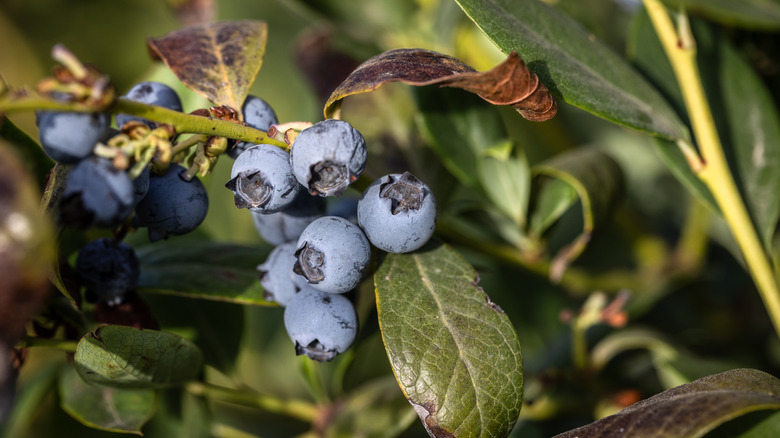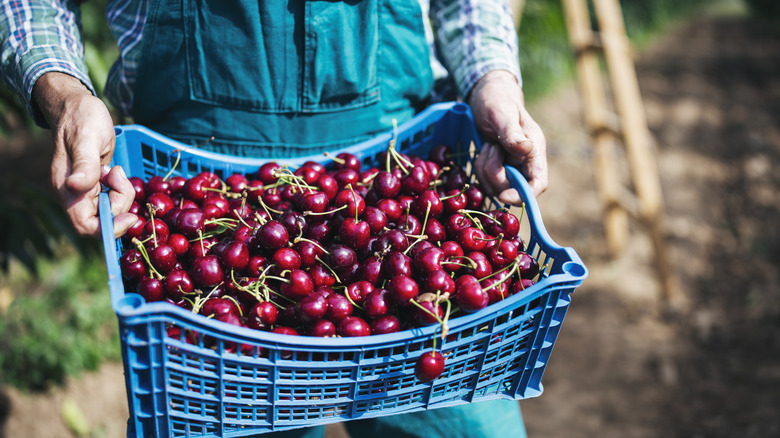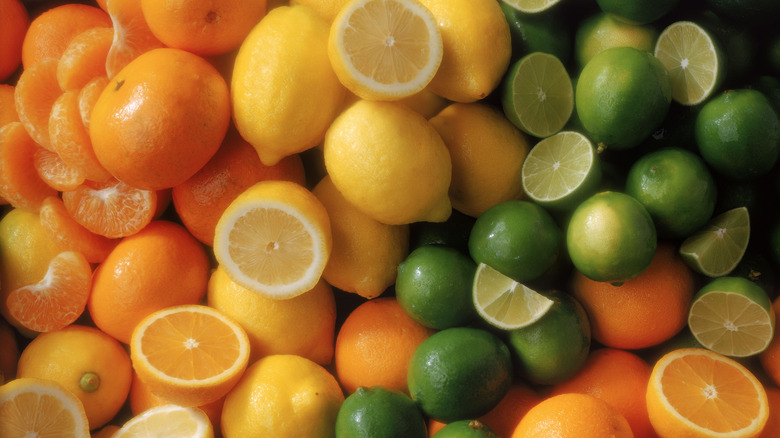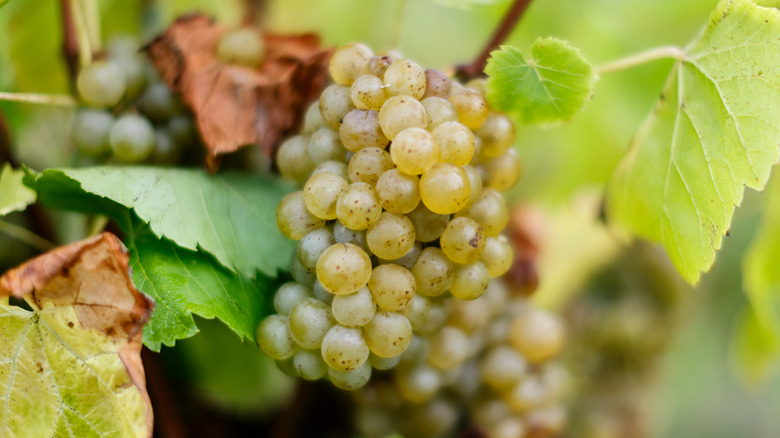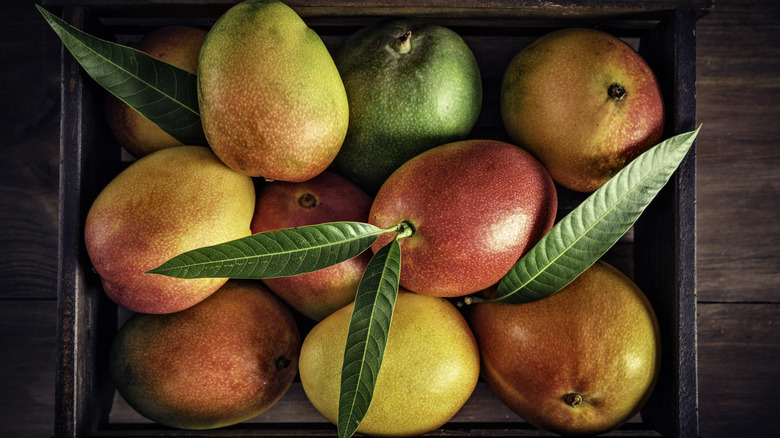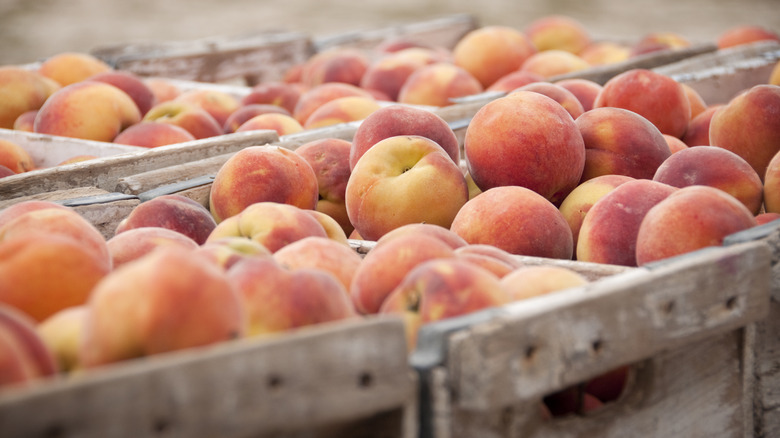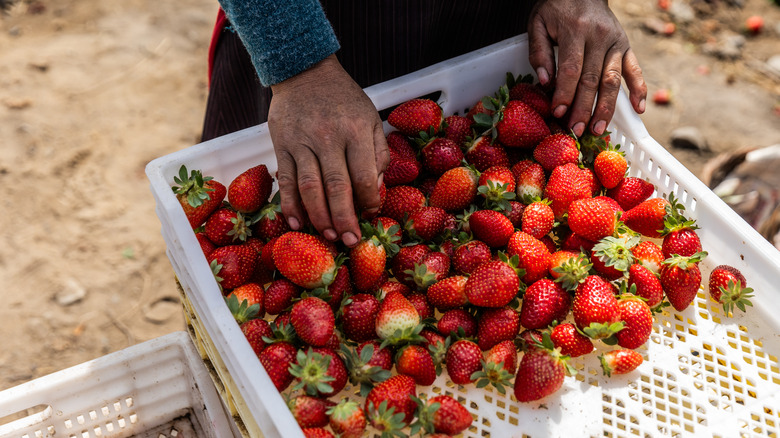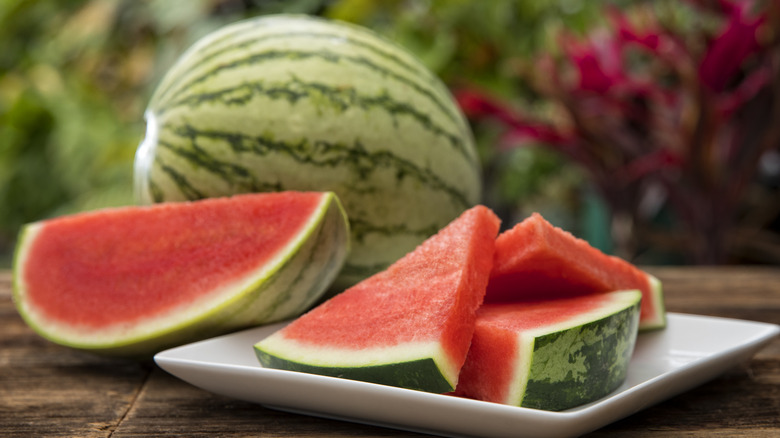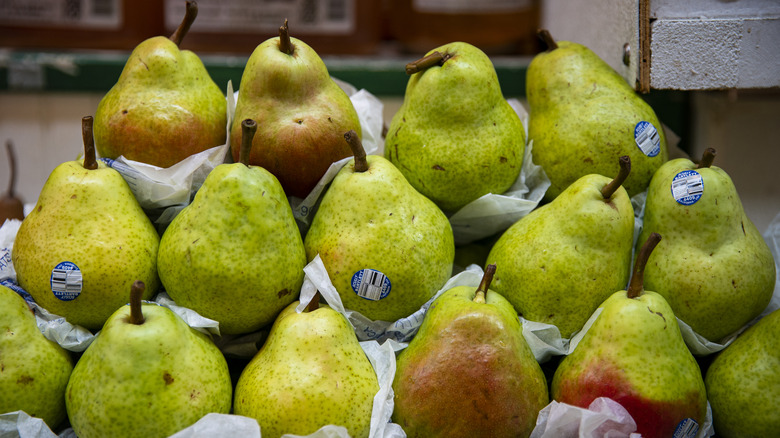How To Store 12 Fruits To Ensure They Stay Fresh
Having a surplus of leftover fruit in the house at some point is extremely likely, whether due to holiday celebrations or going on vacation. Between apples used for pies, stocking oranges for after-dinner kids' snacks, or keeping a pile of grapes on hand for your many cheese and charcuterie boards, chances are your refrigerator, counters, and pantries will be overflowing with sweet produce.
But keeping that fruit fresh and delicious over time is a balancing act in and of itself. There's no one-size-fits-all approach when it comes to storing fruit, after all, and ensuring you get your money's worth for each type of fruit can be challenging. Still, it's not impossible, and keeping your oranges sweet, or your pears crisp, can be done with the right approach.
Since the risk of ending up with fruit that's brown, wilted, or wrinkled — i.e. just plain yucky — is always looming, it's helpful to know the proper storage technique for common fruits. To help you battle the inevitable, here's how to store 12 fruits to ensure they stay fresh.
Apples
Have you ever ventured out to an orchard and picked your literal weight in apples ... only to get home and realize that $50 worth of apples is a lot to eat in a short period? You may be in search of some guidance on how to store the fruit over time. Thankfully, whether you're swimming in an abundance of Red Delicious, Gala, or Granny Smith apples, the rules for keeping them fresh are pretty similar between varieties.
First, if you're looking to store apples out in the open — like a large bowl in the middle of a table — they'll last for about a week or so before becoming less crisp (and possibly a bit mealy). Moving that bowl into the less aesthetically-pleasing refrigerator can extend the shelf life of your apples much, much longer — from weeks to months, in some cases.
Perhaps the most important factor in ensuring your apples remain fresh is keeping them away from other fruits. Apples may absorb the scents and tastes of certain fruits or vegetables, like onions, when stored near them. Additionally, the ethylene gas emitted by apples may cause other produce to overripen if placed nearby. So while it may impact your tablescape, your best bet for keeping those apples as fresh as possible — for as long as possible — is by placing them in the fridge (in a bag or a drawer by themselves).
Avocados
Avocados may be the alleged cause of millennial financial woes everywhere. But they're also a delicious fruit that can be used for just about everything, including smoothies, toast-toppers, and your baby's first foods. If you're trying to keep your avocados fresh, plump, and green until it's time to use them, though, you'll need to start in the grocery store.
Selecting avocados largely depends on when you're planning to eat them, as they become progressively softer over time. In other words, you shouldn't be afraid to choose a rock-hard avocado on Saturday if you don't need it until the following Friday. Upon purchasing, store your avocados in a bowl on the countertop until they've reached your desired softness — a bit harder for avocado toast, perhaps, while a bit softer for guacamole.
If your avocados are in or near your desired state of ripeness, but you aren't quite ready to use them? Your best bet is to move them from the counter to the fridge. Contrary to popular belief, it's okay to store avocados in the refrigerator – especially after they've had a chance to ripen on the counter. Moving them into a colder zone helps slow down the ripening process, ensuring they remain in a state of perfect eat-me-now readiness for much longer than on the countertop.
Bananas
Although many of us became banana bread experts during the COVID-19 pandemic, some folks may need a refresher on the best way to store bananas to keep them as fresh as possible over a long period of time. Since bananas are a food you should never refrigerate, they tend to do much better hanging on one of those cute banana racks or in a bowl on your countertop. After all, their tropical origin means they prefer to ripen to peak perfection in a warm, humid environment — and since your house probably isn't humid, warm will have to do.
That being said, many folks do, in fact, opt to keep the bananas they buy in a bowl or basket at room temperature. Of course, once they start to reach that sought-after yellow color? You can actually put them in the refrigerator, as the cold, dry environment will cause the ripening process to slow. And while the peel may get a bit spotty and blacken in the process, the fruit inside should be perfectly fine.
Blueberries
At their peak freshness during the spring and summer, blueberries are a favorite healthy snack thanks to the plethora of nutrients offered by the fruit. Unfortunately, these little blue beauties can turn into a wilted, moldy, and wrinkled mess if they aren't stored correctly.
Now, to truly ensure the long-lasting freshness of blueberries, your best option may be to pick them yourself. Blueberries found on grocery shelves may be weeks old, like other produce (or shipped and cared for in a disturbing manner). Given this, store-bought blueberries may only last a few days once you've gotten them home, and often aren't as flavorful as the ones you pick yourself.
Beyond obtaining your own farm-fresh blueberries, a few additional steps can help you enjoy plump and juicy berries for weeks (or months) in the refrigerator. First, give them a good once-over to remove any wilted, split, or damaged berries. Next, rinse your fresh berries in cold water, then gently pat them dry with paper towels until you've removed any remaining moisture. Line a container with new, dry paper towels after this, then place the blueberries in single layers. Close the container, and store it in the back of your fridge.
Cherries
Whether eaten in a pie, in preserves, or fresh, cherries are a tasty, poppable fruit full of antioxidants — one long-touted for their anti-gout benefits. Thankfully, cherries are pretty easy to store and keep fresh, so you can enjoy their goodness for longer.
Cherries are non-climacteric, so they stop ripening as soon as they're picked (unlike bananas, pears, or peaches, for instance). As a result, cherries don't need to sit on the countertop in a bowl to reach their peak; rather, the best way to store them involves putting them in the fridge — while skipping any washing until you're ready to eat them.
As long as they're not too tightly packed, and have access to good airflow, cherries can stay in a bowl in the fridge. In fact, you don't want to store cherries in any airtight containers, as the buildup of moisture could result in moldy fruit. When you store a good batch of cherries like this, they should last for two to three days.
Citrus
Lemons, oranges, tangerines, grapefruit, and limes may help you achieve the vibe of a Mediterranean kitchen if that's your aim. But knowing how to store your citrus to avoid dried-out or sour fruit seems a bit more important than your decor choices.
If you've just bought a haul of assorted citrus — be it lemons and limes, or grapefruits and pomelos — and plan to use or eat them within a few days, they're likely fine to sit on a countertop in a large bowl. Just remember whatever citrus you have will continue to ripen, so keeping them packed relatively loosely (and out of the sun) will keep them at their best.
If your fruit is already fairly ripe — or if you're not planning to use it immediately — store citrus in the refrigerator in a mesh bag in your crisper drawer. Make sure the fruit has plenty of airflow, though, to prevent excess moisture that could lead to dreaded mold.
Grapes
Red, green, or even pink grapes are a deliciously sweet treat for kids and adults alike. But being able to keep those big bags of vine-ripened fruits fresh can be a bit of a task — and ensuring your grapes remain as fresh as possible starts at the grocery store. Choose bunches that seem overwhelmingly filled with plump, ripe fruit, while avoiding those with a lot of wrinkled, moldy, or blemished grapes.
Once you've chosen your perfect bunch and gotten them home, skip the sink. More than that, don't wash the grapes until you're ready to eat them, as one of the absolute best ways to keep grapes fresh is to avoid moisture as much as possible. Since introducing even a small bit of water can cause grapes to become immediately moldy, it's best to leave grapes unwashed in the bag they came in. Or, in the absence of a bag, place them in an oversized bowl, and scoot them into your refrigerator; a crisper drawer is even better (if you have one).
Don't remove grapes from the vine, either. Loose grapes tend to become less-than-desirable far quicker than their on-the-vine counterparts. Taking these simple steps will ensure your grapes have adequate air circulation, and may allow them to stay fresh for five to 10 days.
Mangoes
Referred to by some as the king of fruits — especially in its native growing region of India — the sweet and juicy mango is a too-often overlooked treat by some in the U.S. But with bright yellow-orange flesh and an abundance of vitamin A and vitamin C, it's a stellar choice for eating raw as is, or adding to smoothies and desserts. Thankfully, if you've come into a few (or many) mangoes, keeping them fresh for as long as possible is relatively simple.
If your mangoes are a bit unripe, the best way to store them really depends on when you're planning to enjoy them. For anyone who wants to eat them sooner rather than later, it may be best to keep them on the counter, as mangoes will ripen more quickly at room temperature. Conversely, mangoes put into the refrigerator will continue to ripen, as well, but much more slowly than those outside the fridge.
Either way, when you're ready to enjoy your perfectly ripe mangos? Peel off the tough outer skin, and either bite right in (avoiding that giant pit), or dice and enjoy.
Peaches
In certain states, peaches are both a right of passage, and a point of pride (New Jersey and Georgia come to mind). But getting those incredibly juicy, luscious fruits to stay as fresh as possible after they've been picked can be a little tricky. With a short growing window — roughly May to August (and maybe September in warmer spots) — peaches are best when they're purchased straight from your local farmer's market.
Once you have your freshly-picked peaches in hand, these climacteric fruits should live on your counter if they're not yet ripe and juicy. However, you shouldn't necessarily be piling them in a bowl. Peaches are prone to bruising, so the best way to store them at room temperature is to lay them out in a single layer. It may not be as pretty as a bowl piled high, but the sanctity of your peaches seems worth it.
If you've happened upon very ripe peaches (or your peaches have reached ultimate ripeness on your counter), move them to the refrigerator into a crisper drawer, or on a plate toward the back. They should last anywhere from three to five days in there, as the ripening process slows way, way down.
Strawberries
Red, piquant, and juicy, strawberries are the ultimate fruit. They can go with cream and with chocolate; on our cereal and our ice cream. Honestly, what can't they do? Well, they can't stay fresh for that long ... unless you take some serious action.
First, when shopping for strawberries — whether in the grocery store, or straight off the vine at a you-pick farm — make sure your berries are bright, plump, and unblemished. At the grocery, carefully inspect the containers holding your strawberries. Keep an eye out for moldy or weepy fruit, which can transfer moisture — and ruin the whole bunch. Once you've got your fruit home, the best way to keep those strawberries fresh is to put them in the fridge immediately. Put them in a single layer on top of a paper towel, and don't wash them until you're ready to eat them.
Storing strawberries in a cool and dry place, like the refrigerator, allows you to enjoy fresh berries for about a week (and possibly more). To preserve strawberries for up to two weeks, soak them in a bowl filled with 1 cup of cold water, and ¼ cup of distilled white vinegar for about five minutes. Remove and rinse them in cold water, then dry them thoroughly before placing them in the fridge in a single layer on a paper towel.
Watermelon
Watermelon may be everyone's favorite summer fruit. This tasty treat can be devoured one slice at a time, in a giant fruit salad, or as part of a refreshing smoothie or cocktail. Of course, wrangling (and slicing) a whole one is certainly a feat. But keeping your watermelon fresh, sweet, and juicy is easier than it looks.
Watermelons are non-climacteric, meaning once they're picked? They won't ripen any further. Despite this, watermelons can still soften in your kitchen at room temperature, and are susceptible to damage if not stored correctly.
With this in mind, whole, uncut watermelons are best when stored between 50 to 60 degrees. Coolers with ice packs — and a towel between your melon and the frozen stuff — will work well, too, as will a root cellar (if you have one, that is). Once you cut into your watermelon, keep it in an airtight container in your refrigerator, where it should last between four and seven days.
Pears
From Bosc to Bartlett, pears may be just as popular in the United States as apples. The sweet, white fruit — featuring smooth or leathery skin — is in season from August to October (depending on the variety), and is often utilized for both canning and storing. But if you're more interested in enjoying your pears fresh, there are a few pointers regarding how to keep them at their best for longer.
Pears are the type of the fruit that continues to ripen once they've been picked. So placing some not-quite-ripe ones in a bowl with good airflow at room temperature (out of the sun) is a surefire way to get them there a bit faster. You can also store them in a paper bag with apples or bananas to help them ripen a bit faster, as those two fruits produce ethylene gas.
If your pears are already fairly ripe — that is, they have a little softness when touched (but not too much) — you can place them in the fridge to slow the process. They do tend to bruise easily, though, so keeping them in a single layer in your crisper drawer is your best option to maintain their aesthetic appeal.
